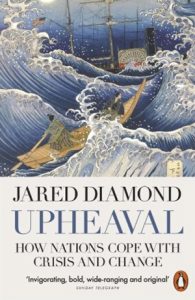Upheaval: How Nations Cope with Crisis and Change (or don't)

Author: Jared Diamond
Publisher: Allen Lane
Year of Publication: 2019
Print Length: 320 pages
Genre: Non-Fiction / Anthropology, Biology, History, Psychology, Popular Science, Political Science, Social Science, Popular Science
Area: Global, Finland, Japan, Chile, Indonesia, Germany, Australia, The United States of America (USA), Asia-Pacific
Topic: Crisis / Crises, Change, Nation-Building & Nationhood, Resilience, Culture & Society, Politics & Power, History
In his landmark international bestsellers Guns, Germs and Steel and Collapse, Jared Diamond transformed our understanding of what makes civilizations rise and fall. Now, at a time when crises are erupting around the world, he reveals what makes certain nations resilient in the face of tremendous upheaval.
In a riveting journey into the recent past, he traces how six countries have survived defining catastrophes – from the forced opening of Japan to the Soviet invasion of Finland to Chile’s brutal Pinochet regime – through selective change, a coping mechanism more commonly associated with personal trauma. He identifies unique patterns in the way that these distinctive modern nations – all countries in which he has lived – have recovered from these upheavals.
Looking ahead to the gravest threats we face in the future, he investigates the risk that the United States, and the world, are squandering their natural advantages and are on a devastating path towards catastrophe. Is this fate inevitable? Or can we still learn from the lessons of the past?
Adding a psychological dimension to the in-depth history, geography, biology, and anthropology that mark all of Diamond’s books, Upheaval reveals the factors that influence how both nations and individuals can respond to enormous challenges. The result is a book epic in scope, but also his most personal yet.
Table of Contents
Prologue: Legacies of Cocoanut Grove
Two stories — What’s a crisis? — Individual and national crises — What this book is and isn’t — Plan of the book
Part 1. Individuals
1. Personal Crises
A personal crisis — Trajectories — Dealing with crises — Factors related to outcomes — National crises
Part 2. Nations: Crises that Unfolded
2. Finland’s War with the Soviet Union
Visiting Finland — Language — Finland until 1939 — The Winter War — The Winter War’s end — The Continuation War — After 1945 — Walking a tightrope — Finlandization — Crisis framework
3. The Origins of Modern Japan
My Japanese connections — Japan before 1853 — Perry — 1853 to 1868 — The Meiji Era — Meiji reforms — “Westernization” — Overseas expansion — Crisis framework — Questions
4. A Chile for All Chileans
Visiting Chile — Chile until 1970 — Allende — The coup and Pinochet — Economics until “No!” — After Pinochet — Pinochet’s shadow — Crisis framework — Returning to Chile
5. Indonesia, the Rise of a New Country
In a hotel — Indonesia’s background — The colonial era — Independence — Sukarno — Coup — Mass murder — Suharto — Suharto’s legacies — Crisis framework — Returning to Indonesia
6. Rebuilding Germany
Germany in 1945 — 1945 to 1961 — Germans holding judgment — 1968 — 1968’s aftermath — Brandt and re-unification — Geographic constraints — Self-pity? — Leaders and realism — Crisis framework
7. Australia: Who Are We?
Visiting Australia — First Fleet and Aborigines — Early immigrants — Towards self-government — Federation — Keeping them out — World War One — World War Two — Loosening the ties — The end of White Australia — Crisis framework
Part 3. Nations and the World: Crises Underway
8. What Lies Ahead for Japan?
Japan today — Economy — Advantages — Government debt — Women — Babies — Old and declining — Immigration — China and Korea — Natural resource management — Crisis framework
9. What Lies Ahead for the United States? Strengths, and the Biggest Problem
The U.S. today — Wealth — Geography — Advantages of democracy — Other advantages — Political polarization — Why? — Other polarization
10. What Lies Ahead for the United States? Three “Other” Problems
Other problems — Elections — Inequality and immobility — So what? — Investing in the future — Crisis framework
11. What Lies Ahead for the World?
The world today — Nuclear weapons — Climate change — Fossil fuels — Alternative energy sources — Other natural resources — Inequality — Crisis framework
Epilogue: Lessons, Questions, and Outlook
Predictive factors — Are crises necessary? — Roles of leaders in history — Roles of specific leaders — What next? —Lessons for the future
Acknowledgments
Illustration Credits
Further Readings
Index
Further Reading
Notes

Jared Diamond is a professor of Geography and Physiology at the University of California (UCLA). He is equally renowned for his work in the fields of ecology and evolutionary biology, and for his ground-breaking studies of the birds of Papua New Guinea. Author of eight books and numerous academic monographs, Diamond’s best-selling The Rise and Fall of the Third Chimpanzee won two science prizes in 1992. It was the 1997 publication of Guns, Germs and Steel, which sealed Diamond’s global reputation. The book has since won the Pulitzer Prize, been translated into 25 languages and sold millions of copies around the world.
Source: https://www.pbs.org/gunsgermssteel/about/jared.html
More from Jared Diamond in this library, click here.
